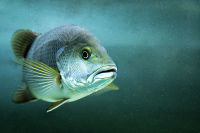Mangrove Red Snapper (Lutjanus argentimaculatus)
From The Aquarium Wiki
Mangrove Red Snapper
Lutjanus argentimaculatus
946 Litres (250 US G.)
100-150 cm (39.4-59.1")
7.5 - 7.8
16 -30 °C (60.8-86°F)
8-18 °d
1:1 M:F
10-18 years
Family
Lutjanidae
| You can contribute to the Aquarium Wiki by expanding this article. Dont be shy!. |
Contents
Additional names
- Mangrove Red Snapper, Mangrove Jack
Tank compatibility[edit]
- The Mangrove Jack will feed at all levels of the aquarium. As the fish gets habituated to surface feeding, it will eat most of the food put into the aquarium before it can sink to the substrate. This fish is a very aggressive feeder and feeding times can be spectacular.
- In regards to tank mates compatibility, "be very careful" is the short answer. Jacks may co habit reasonably well as small juveniles, but as they grow their predatory and aggressive nature will be expressed more strongly. Like many predators Jacks are particularly aggressive and will eat anything small enough to fit in its mouth and kill tank mates that are too large to eat.
Diet[edit]
- The Mangrove Jack is not particular in what it eats.
- In captivity, freshly imported jacks may need live food to build size during acclimatization, if the fish is wild caught the will generally need live food. If the fish is farmed it may already be ready to take prepared foods. If your fish is not ready to take prepared food it is common to start by feeding river shrimps, small feeder fish and acclimating it to eating dead items.
Feeding regime[edit]
- Initially feed your young jack two to three times per day. As the jack grows lessen feedings to once per day, with a day long fast once a week
Environment specifics[edit]
- Juveniles are found in mangrove freshwater/brackish estuaries, adults move out to the oceans and are found around coral reefs to a depth of 100m.
Pictures[edit]
External links[edit]
- Fishbase (Mirrors:
 )
)

